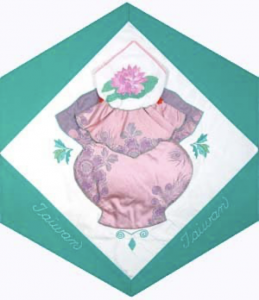Taiwan

The Block
The Taiwan block features a beautiful piece of silk woven in an intricate design by blockmaker Ming Chan Su. This fabric is actually a layered pocket taken from an apron belonging to the block-maker’s grandmother who wore it underneath her clothing. The front flap lifts up to reveal a hidden pouch in which a small amount of money would be kept. Aprons like these were often given to children so they would have a place to keep their hankies. A lotus, commonly found throughout the Taiwan countryside, is finely stitched onto a piece of white cloth that is tucked inside a second pouch.
Cultural Profile
Taiwan, called Ilha Formosa, ‘the beautiful island’ in Portuguese, is an island in the Pacific Ocean located off the eastern coast of China. Its mountains, spectacular waterfalls, subtropical forests and tea and rice fields sit side by side with dazzling urban landscapes. The official language is Guoyu (Mandarin Chinese) and the most popular foreign language spoken is English. There are also around 15 indigenous languages spoken here.
Because of its unique historical and geographical background, Taiwan has a versatile culture incorporating elements of many different ethnic groups such as Han Chinese, indigenous groups and the Japanese. The population is made up of Chinese people, who started to come to the island in the 16th century, and more than 530,000 indigenous people, from the 10 different tribes which make up the aboriginal group. These indigenous groups are related to other Austronesian people such as Filipinos, Malays and Indonesians rather than Chinese. Taiwan has the second highest population density in the world. It is also a major economic player in Asia producing high-tech goods as well as tropical fruits and delicate teas.
Although a friendly people, Taiwanese will rarely express their emotions in public. Saving face is important and the behaviour of each member reflects on the entire family.
Taiwan has many unique forms of art expression, as seen in its jade carving, pottery and ceramics. It is also known for its calligraphy, silk and brocade fabrics, and lacquer ware. The art of paper cutting has been passed down from generation to generation and is a recreation that nourishes the mind and cultivates patience and concentration. The making of paper umbrellas and fabric lanterns are also common activities in Taiwan. Wood carving, especially using the native and odorant cypress tree, is also an important craft visible in the various temples on the island.
One of the artistic traditions most cherished by the Taiwanese people is the puppet theatre. It is seen as a way to preserve and transmit traditional Taiwanese culture. Taiwanese opera, with its eight customary roles, is also a very important tradition using traditional instruments such as the yehu, the jinghu and the daguangxian (bowed string instruments), and the suona (a type of horn).
Previously listed under ‘Formosa’, Taiwanese are on record as having been coming to Canada since 1974, settling mainly in the larger cities of Toronto, Montreal and Vancouver. They have established schools and restaurants and many students stay in touch with other Taiwanese through the Federation of Taiwanese Student Associations, the largest of its kind in Canada. There are now over 30,000 Taiwanese living in Canada.
Sponsor: Reginald and Keitha Melrose
